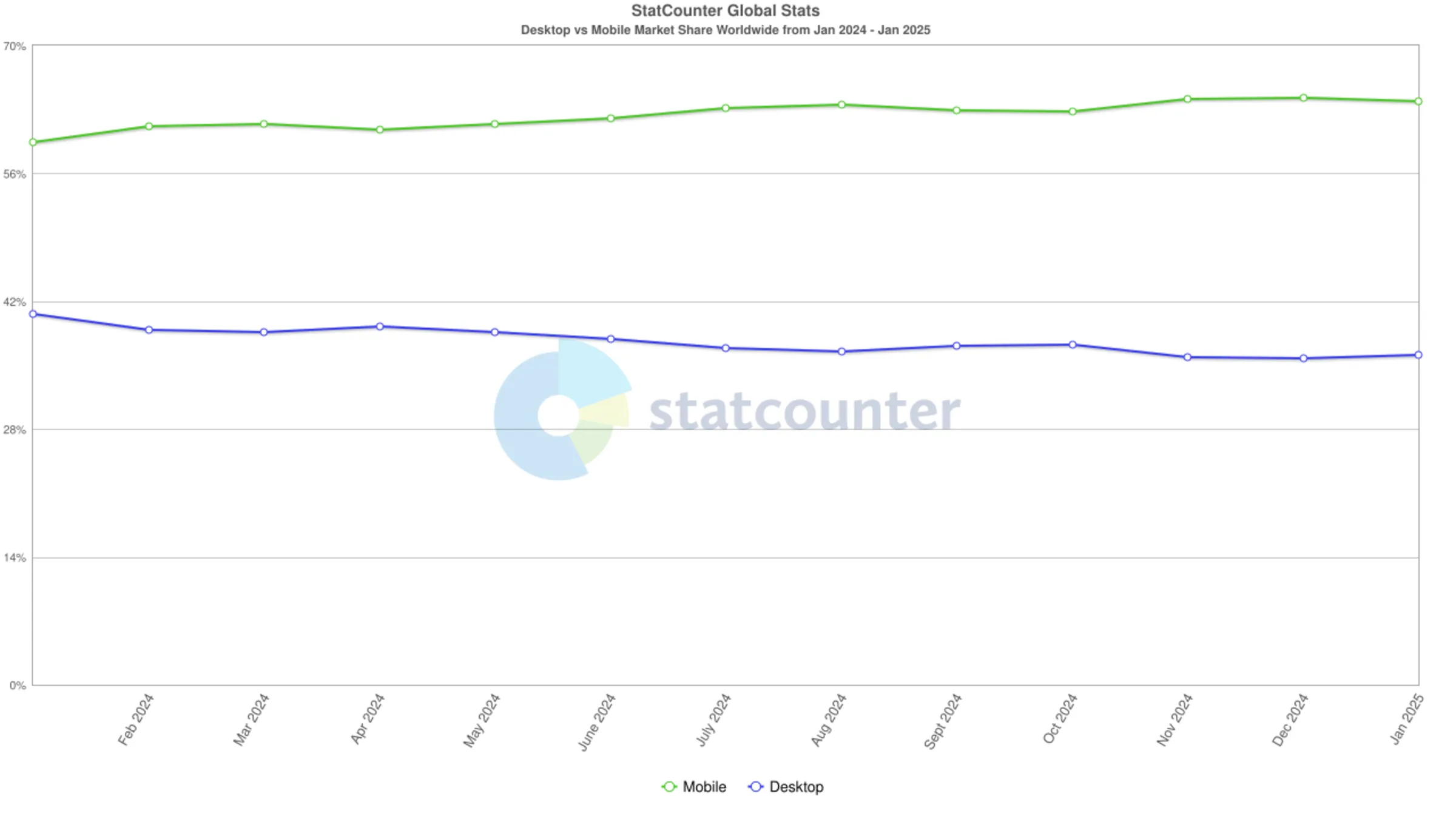Having a website is essential for any small business, but simply having one isn’t enough. If your site is not designed and optimized correctly, it can drive away potential customers instead of attracting them. Here are some of the most common website mistakes small businesses make and what you can do to fix them.
1. Poor Mobile Experience
As of January 2025, mobile devices account for approximately 63.89% of global web traffic, highlighting the critical importance of mobile optimization for small business websites.

Despite this significant shift towards mobile browsing, many small business websites remain unoptimized for mobile users. This oversight can lead to a frustrating user experience, characterized by difficult navigation, slow load times, and unreadable content on smaller screens. Such issues can deter potential customers, increasing bounce rates and reducing conversions.
How to Fix It
- Implement Responsive Design: Ensure your website adapts seamlessly to various screen sizes and orientations, providing an optimal viewing experience across all devices.
- Conduct Mobile Testing: Regularly test your website on multiple mobile devices and browsers to identify and rectify usability issues.
- Optimize Touch Elements: Design buttons and links that are appropriately sized and spaced for easy tapping, enhancing overall navigation and user satisfaction.
2. Slow Load Times
As I often teach in my classes, if you have a beautiful site but it loads slow, then your site does not matter. Or, to put it another way, a Toyota engine in a Ferrari is not a Ferrari.
Website speed is a critical factor in user retention and conversion rates. Studies have shown that as page load time increases from 1 second to 3 seconds, the probability of bounce increases by 32%. Additionally, a 1-second delay in page load time can result in 11% fewer page views, a 16% decrease in customer satisfaction, and a 7% loss in conversions.
One point of note is that many marketing companies will use Google’s PageSpeed, Pingdom, GTMetrix, and other services to show you how your site might load slowly (especially in an effort to gain your business). These metrics are useful and should be considered, but also be aware that they sometimes do not reflect the actual experience your customers are having.
How to Fix It
- Optimize Images: Compress and resize images to reduce file sizes without compromising quality.
- Utilize Caching and Content Delivery Networks (CDNs): Implement browser caching and use CDNs to distribute content more efficiently.
- Minimize Heavy Scripts and Plugins: Remove unnecessary scripts and plugins that may slow down your website. Put careful consideration into what you’re adding to your site and the impact with loading.
3. Lack of Clear Call-to-Actions (CTAs)
Clear and compelling CTAs are essential for guiding visitors toward desired actions. Surprisingly, 70% of small business B2B websites lack a CTA, leading to missed opportunities for conversions. Embedding CTAs within your content can increase conversion rates by 121% compared to traditional banner ads.
How to Fix It:
- Use Prominent Buttons with Action-Oriented Text: Design CTAs that stand out and use persuasive language, such as “Get Your Free Quote” or “Sign Up Now.”
- Avoid Generic CTAs: Steer clear of vague prompts like “Click Here.” Instead, provide specific instructions that align with your goals. “Sign Up Today” and “Schedule an Appointment” and “Call Our Office” are more specific, more clear, and direct your customer.
- Strategically Place CTAs: Position CTAs in areas where users are most likely to engage with them, such as at the end of blog posts or in strategic locations on landing pages.
4. Ignoring SEO Basics
Without proper search engine optimization (SEO), your website may struggle to attract organic traffic. SEO is crucial for improving visibility and reaching potential customers. Neglecting SEO can result in lower search rankings, making it difficult for users to find your business online.
How to Fix It:
- Incorporate Relevant Keywords: Research and include keywords that your target audience is likely to use when searching for your products or services.
- Optimize Title Tags and Meta Descriptions: Craft compelling and descriptive titles and meta descriptions that accurately reflect your content and entice users to click.
- Regularly Publish High-Quality Content: Create valuable and informative content that addresses the needs and interests of your audience, establishing your authority in the industry.
Many small business owners often wonder about the role of AI in content creation. While AI is a fantastic tool for generating high-quality content quickly and efficiently, it should not replace the unique insights and expertise that only you, as a business owner, can provide. AI can help you draft articles, suggest topics, and even enhance your writing process, but it’s crucial to add your own voice, your years of experience, and your personal approach to customers in the area you serve. This ensures your content reflects your brand’s values and connects with your audience in a way that resonates authentically.
5. Poor Navigation and Cluttered Design
A complicated or cluttered website design can confuse visitors and hinder their ability to find information. Effective navigation is essential for a positive user experience. Websites with clear and intuitive navigation can significantly reduce bounce rates and increase the time users spend on your site.
How to Fix It:
- Simplify Menus: Limit the number of menu items to essential categories, making it easier for users to find what they need.
- Organize Content with Clear Headings: Use descriptive headings and subheadings to break up content and guide users through your pages.
- Utilize Whitespace Effectively: Incorporate whitespace to create a clean and organized layout, enhancing readability and focus.
6. Implement Security
Security is a major concern for website visitors. Websites lacking an SSL certificate are marked as “Not Secure” by browsers, which can erode trust and deter users from engaging with your site. Moreover, search engines like Google consider SSL certification as a ranking factor, impacting your site’s visibility.
How to Fix It:
- Obtain an SSL Certificate: You don’t always need to purchase an SSL certificate—many reliable hosting providers offer free SSL certificates (such as Let’s Encrypt). These certificates still provide robust encryption and secure user data, helping you maintain trust and improve SEO.
- Enable HTTPS: Once you have an SSL certificate, make sure your website is accessible via HTTPS. This ensures a secure connection for users, and it’s essential for maintaining your site’s search engine rankings.
- Choose a Reliable Hosting Provider: Select a hosting provider that supports free SSL certificates and provides easy installation options. Many hosts offer free SSL as part of their hosting plans, making it simpler to secure your website.
7. Lack of Contact Information
Accessible contact information is vital for building trust and facilitating communication with potential customers. If visitors cannot easily find how to reach you, they may become frustrated and leave your site. Providing multiple contact options enhances credibility and encourages user engagement.
How to Fix It:
- Display Contact Information Prominently: Place contact details, such as phone numbers and email addresses, in easily noticeable areas, like the header or footer of your website.
- Include Multiple Contact Methods: Offer various ways for users to reach you, including contact forms, email addresses, phone numbers, and physical addresses if applicable. It should go without saying, but make sure that you check and respond to these points of contact.
- Consider Adding Live Chat: If your business can support it, and it makes sense for your industry, implement a live chat feature to provide immediate assistance and answer user inquiries in real-time. Do not implement live chat if you do not have the ability to respond in a reasonable time. This will only frustrate your customers as they will expect quicker response times than you may be able to provide.
8. No Regular Updates or Fresh Content
An outdated website can give the impression that your business is inactive or unprofessional. Regularly updating your website with fresh content not only engages visitors but also positively influences your search engine rankings. Websites that consistently publish new content are more likely to attract repeat visitors and generate leads.
How to Fix It:
- Maintain an Active Blog: Regularly publish articles, news updates, or insights related to your industry to keep your audience informed and engaged.
- Show Off Your Recent Work: Customers love to see your work, no matter what industry. Make regular updates to show off your projects and your give customers more reason to use your business.
- Update Product and Service Information: Ensure that all offerings are current, with accurate descriptions, pricing, and availability.
Conclusion
Your website is often the first impression potential customers have of your business. (Some statistics put over 80% of shoppers will go to your website first before they will reach out to you!) Avoiding these common mistakes can help you create a site that engages visitors, builds trust, and drives conversions. Need help optimizing your small business website? Contact us today for expert website design and digital marketing solutions!


